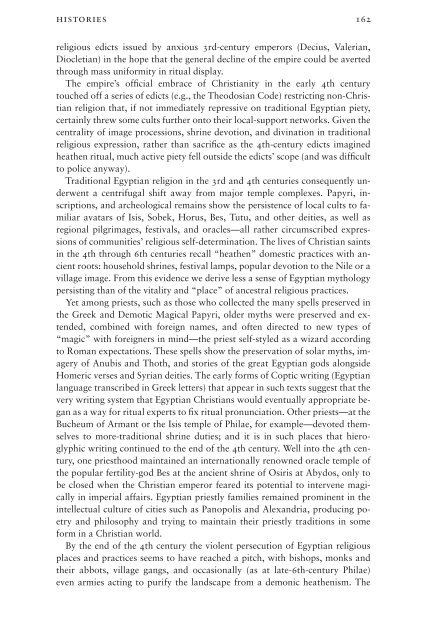You also want an ePaper? Increase the reach of your titles
YUMPU automatically turns print PDFs into web optimized ePapers that Google loves.
histories 162<br />
religious edicts issued by anxious 3rd-century emperors (Decius, Valerian,<br />
Diocletian) in the hope that the general decline of the empire could be averted<br />
through mass uniformity in ritual display.<br />
The empire’s official embrace of Christianity in the early 4th century<br />
touched off a series of edicts (e.g., the Theodosian Code) restricting non-Christian<br />
religion that, if not immediately repressive on traditional Egyptian piety,<br />
certainly threw some cults further onto their local-support networks. Given the<br />
centrality of image processions, shrine devotion, and divination in traditional<br />
religious expression, rather than sacrifice as the 4th-century edicts imagined<br />
heathen ritual, much active piety fell outside the edicts’ scope (and was difficult<br />
to police anyway).<br />
Traditional Egyptian religion in the 3rd and 4th centuries consequently underwent<br />
a centrifugal shift away from major temple complexes. Papyri, inscriptions,<br />
and archeological remains show the persistence of local cults to familiar<br />
avatars of Isis, Sobek, Horus, Bes, Tutu, and other deities, as well as<br />
regional pilgrimages, festivals, and oracles—all rather circumscribed expressions<br />
of communities’ religious self-determination. The lives of Christian saints<br />
in the 4th through 6th centuries recall “heathen” domestic practices with ancient<br />
roots: household shrines, festival lamps, popular devotion to the Nile or a<br />
village image. From this evidence we derive less a sense of Egyptian mythology<br />
persisting than of the vitality and “place” of ancestral religious practices.<br />
Yet among priests, such as those who collected the many spells preserved in<br />
the Greek and Demotic Magical Papyri, older myths were preserved and extended,<br />
combined with foreign names, and often directed to new types of<br />
“magic” with foreigners in mind—the priest self-styled as a wizard according<br />
to Roman expectations. These spells show the preservation of solar myths, imagery<br />
of Anubis and Thoth, and stories of the great Egyptian gods alongside<br />
Homeric verses and Syrian deities. The early forms of Coptic writing (Egyptian<br />
language transcribed in Greek letters) that appear in such texts suggest that the<br />
very writing system that Egyptian Christians would eventually appropriate began<br />
as a way for ritual experts to fix ritual pronunciation. Other priests—at the<br />
Bucheum of Armant or the Isis temple of Philae, for example—devoted themselves<br />
to more-traditional shrine duties; and it is in such places that hieroglyphic<br />
writing continued to the end of the 4th century. Well into the 4th century,<br />
one priesthood maintained an internationally renowned oracle temple of<br />
the popular fertility-god Bes at the ancient shrine of Osiris at Abydos, only to<br />
be closed when the Christian emperor feared its potential to intervene magically<br />
in imperial affairs. Egyptian priestly families remained prominent in the<br />
intellectual culture of cities such as Panopolis and Alexandria, producing poetry<br />
and philosophy and trying to maintain their priestly traditions in some<br />
form in a Christian world.<br />
By the end of the 4th century the violent persecution of Egyptian religious<br />
places and practices seems to have reached a pitch, with bishops, monks and<br />
their abbots, village gangs, and occasionally (as at late-6th-century Philae)<br />
even armies acting to purify the landscape from a demonic heathenism. The








